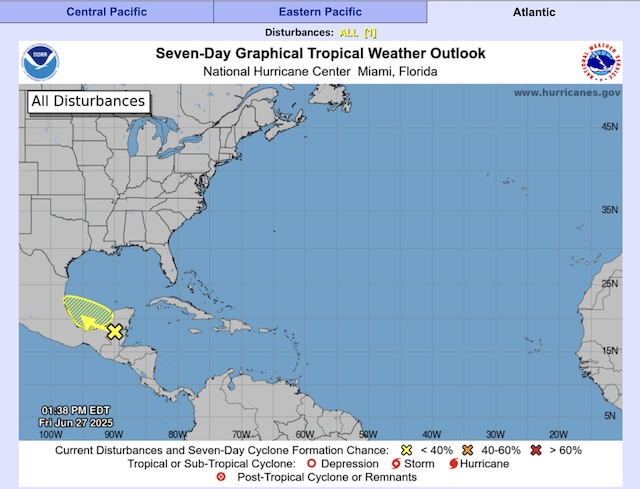Weather and Hurricanes: Critical Forecast Tool Now to Remain Online
A critical source of high-quality hurricane forecasting data which was to be permanently discontinued from June 30th, 2025, when the U.S. Department of Defense terminated the Defense Meteorological Satellite Program (DMSP) will now remain online until 2026.
Published 6 months ago, updated 4 months ago
In a Reversal, Key Hurricane-Monitoring Data Will Stay Online
Update: August 2025 – New York Times
The New York Times is reporting that Key Hurricane Monitoring Data will stay online after the United States Department of Defense said it no longer planned to shut down a program that makes satellite data publicly available to researchers and forecasters.
The National Atmospheric and Oceanic Administration, which hosts the data, shocked scientists by announcing in June that it would stop providing the information at the end of that month, citing “significant cybersecurity risk.” A week later, the agency offered a temporary extension, saying that the data would remain available until July 31, which is just before the usual peak of hurricane season.
Then, two days before the latest end-of-month deadline, the agency decided to keep the program running indefinitely. According to a Navy spokesperson who declined to be identified (to the New York Times) it (the program) will remain available until the sensors stop working or until the program formally ends in September 2026.
Essential Real-Time Data
The Defense Meteorological Satellite Program (DMSP) provides essential real-time microwave data from three active weather satellites. The program’s termination of data products could lead to dangerous declines in the quality of hurricane forecasts, especially as the termination comes in the middle of the 2025 hurricane season according to media reports.
The decision is expected to significantly degrade hurricane forecasting capabilities, particularly concerning rapid intensification and accurate storm positioning according to metereologists.
Key Points and What This Means for Sailors:
1. Reduced Forecast Accuracy, Especially for Rapid Intensification:
- The DMSP satellites provide roughly half of all microwave scans crucial for “seeing” beneath hurricane clouds and discerning the storm’s internal structure.
- This microwave data is vital for identifying rapid intensification (RI) – when a tropical storm quickly strengthens into a major hurricane in a matter of hours. Without this data, forecasters will have a significantly harder time predicting these dangerous, sudden increases in wind speed.
- This may mean less warning for rapidly intensifying storms. Be prepared for faster-than-anticipated changes in storm strength, potentially leaving less time for securing vessels or seeking shelter.
2. Increased Risk of “Sunrise Surprise”:
- Microwave data is particularly valuable at night when traditional visible and infrared satellites are less effective at revealing internal storm details.
- The loss increases the risk of a “sunrise surprise,” where a storm’s significant organization or intensification overnight is only fully realized with the first light of day.
- Overnight developments in storms may be less accurately captured. Maintain heightened vigilance and consider more conservative safety margins, especially during nighttime hours in proximity to a developing system.
3. Poorer Storm Track Forecasts:
- Microwave data is used to “fix” or accurately position the center of storms, especially weaker systems where the eye isn’t well-defined.
- Small errors in initial storm positioning can lead to “outsized forecast errors” in track predictions several days out.
- Expect increased uncertainty in storm track forecasts, particularly for weaker systems and in the 4-5 day outlook. Do not rely solely on the exact forecast track; consider the cone of uncertainty and potential deviations.
4. Impact on Hurricane Intensity Estimation Tools:
- AI-driven neural networks, like DMINT, which are crucial for estimating storm intensity, heavily rely on the now-discontinued microwave data.
- The overall quality and reliability of intensity estimations, especially when hurricane hunter aircraft are not available, will likely decrease.
5. Data Scarcity:
- While other microwave data sources exist (e.g., NASA, Japan), the DMSP satellites provided approximately 50% of the total available microwave data. This means data availability will be significantly cut, leading to longer gaps between scans.
- Hurricane hunting aircraft also provide vital data but are limited in their coverage, especially in the Pacific.
- A new satellite (WSF-M) was launched in April 2024 but its data is not yet available to forecasters.
- Forecasters will be working with less frequent and less comprehensive data. This directly translates to greater challenges in providing timely and precise updates.
Current Atlantic Outlook:
As of late June, forecast models indicate a quiet Atlantic basin for at least the next week, with no development expected. However, this immediate calm does not mitigate the long-term concerns regarding the degradation of forecasting tools for the remainder of the hurricane season and beyond.


This summary is based on information from various sources, including news reports and statements. For more detailed information see the following links:
For more information:
- Critical Hurricane Forecast Tool Abrubtly Terminated – Eye on the Tropics
- Trump Terminates Satellite Data Crucial to Hurricane Forecasting – E&E News by Politico
- NOAA Service Notice
…………………………………
Related Links:
- National Hurricane Center
- Defense Meteorological Satellite Program
- National Oceanic and Atmospheric Administration (NOAA)
…………………………………
Noonsite has not independently verified this information.
If you have found this information useful, become a paid member to enjoy unlimited use of Noonsite plus many other perks. Your membership fees really help our small, dedicated team keep country information up-to-date in support of cruisers worldwide. Find out more about Noonsite Membership levels and benefits here.
Subscribe to our FREE monthly newsletter: https://www.noonsite.com/newsletter/
Related to following destinations: Abaco Islands, Ambergris Cay, Amelia Island, Andros, Anegada, Anguilla, Anse Marcel, Anse Mitan, Antigua, Antigua & Barbuda, Aruba, Bahamas, Baracoa, Barahona, Barbuda, Barcadera, Basse Terre, Basseterre, Beef Island, Belize, Belize City, Bequia, Bermuda, Berry Islands, Big Creek (Placencia), Bimini Islands, Blowing Point, Blue Lagoon, Boca Chica, Bonaire, Boqueron, Bowden Harbour/Port Morant, Bradenton, Britannia Bay - Lovell, British Virgin Islands, Canouan, Cap Haitien / Labadie, Cap Mole St. Nicolas, Cape Canaveral, Carrabelle / Apalachicola, Casa de Campo, Casilda (Trinidad), Castries, Cat Island, Caye Caulker, Cayo Coco-Guillermo, Chaguaramas, Charlestown, Charlotteville, Chateaubelair, Cienfuegos, Clarkes Court Bay, Codrington, Conception Island, Cooper Island, Corpus Christi, Crabbs Peninsula, Crooked Island District, Cuba, Culebra, Curacao, Daytona Beach, Deshaies, Destin / Fort Walton, Dominica, Dominican Republic, East Coast (USA), El Colony, Eleuthera, English Harbour, Exuma, Fajardo, Falmouth Harbour, Florida, Fort Bay (Fort Baai), Fort Lauderdale, Fort Myers, Fort Pierce, Fort-de-France, Freeport (Texas), Global, Grand Bahama Island, Grand Turk (Cockburn Town), Great Harbour, Great Inagua, Grenada, Grenville, Guadeloupe, Guanica, Gulf Coast, Gun Creek (Virgin Gorda), Gustavia, Haiti, Half Moon Cay, Hamilton - Bermuda, Havre de la Trinite, Havre du Robert, Hemingway Marina (Havana), Hog Island, Houston/Galveston, Iles des Saintes, Ireland Island (Sandys Parish), Isla de la Juventud, Isla de Mona, Isla de Mona, Jacksonville, Jamaica, Jolly Harbour, Jost van Dyke, Jupiter, Key Biscayne, Key Largo, Key West, Kingston, Kingstown, Kralendijk, Las Salinas, Les Anses d'Arlet, Little Bay, Long Island, Luperon, Main Island, Manzanillo, Marathon, Maria La Gorda, Marie Galante, Marigot, Marigot Bay (St. Lucia), Marigot Bay (St. Martin), Marin, Marina Cayo Largo, Marina Los Morros, Martinique, Matagorda, Mayaguana, Mayaguez, Mayreau, Melbourne (Florida), Mero, Miami, Middle Caicos, Miquelon, Mississippi, Mobile Bay, Monte Cristi, Montego Bay, Montserrat, Mt Hartman Bay, Mustique, Nanny Cay, Naples (Florida), Nature Coast, Nevis, New Orleans, Norman Island, North Caicos, Ocho Rios, Oracabessa, Oranjestad, Oranjestad, Other Islands (BVI), Ottley Hall, Out Islands, Oyster Pond, Oyster Pond, Palmas del Mar, Panama City, Parham Town, Pensacola, Peter Island, Petit Martinique, Philipsburg, Pointe-a-Pitre, Ponce, Port Antonio, Port Egmont (Le Phare Bleu Bay), Port Elizabeth (Bequia), Port Louis (Guadeloupe), Port Morgan (Ile-a-Vache), Port-au-Prince, Portsmouth, Prickly Bay, Providenciales, Puerto de Vita, Puerto Plata (Cofresi), Puerto Real, Puerto Rico, Punta Cana, Punta Gorda, Road Bay, Rodney Bay, Roseau, Saba, Salinas, Samana, San Juan, San Pedro (Ambergris Cay), Santa Lucia, Santiago de Cuba, Santo Domingo, Sapodilla Lagoon, Sarasota, Sauteurs, Scarborough (Tobago), Simpson Bay, Sint Maarten, Soufriere, South Caicos, South Padre Island, Spanish Town (Virgin Gorda Yacht Harbour), Spanish Virgin Islands, St Kitts, St Pierre (Martinique), St. Augustine, St. Barts, St. Croix, St. Davids, St. George's, St. George's Harbour, St. John, St. John's, St. Kitts & Nevis, St. Lucia, St. Martin, St. Petersburg / Tampa Bay, St. Thomas, St. Vincent, St. Vincent & the Grenadines, Statia, Store Bay, Stuart / St. Lucie, Tarpon Springs, The Grenadines, Tobago, Tobago Cays, Tortola, Trinidad, Trinidad & Tobago, Trois Ilets, True Blue Bay, Turks & Caicos, Union Island, US Virgin Islands, USA, Venice, Vieques, Vieux Fort, Virgin Gorda, Wallilabou Bay, Well's and Ladder Bays, West Caicos, West End (Sopers Hole), West Palm Beach, Willemstad, Young Island Cut
Related to the following Cruising Resources: Hurricanes and Tropical Cyclones, Weather








